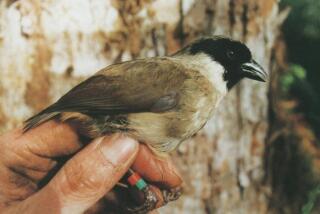A grim landscape of the lost
- Share via
No Turning Back
The Life and Death of Animal Species
Richard Ellis
HarperCollins: 428 pp., $25.95
*
In “No Turning Back,” conservationist Richard Ellis grapples with a vast, complex and eerily depressing panorama of loss. In dedicating his 14th book to his newborn granddaughter, he concedes: “I understand that extinction may not be the ideal subject with which to welcome a newcomer.”
Death and taxes we can count on, but does a grimmer fate await? How about meta-death, the eclipse of one’s own species? For all the dominance Homo sapiens has had on this planet, the odds of eventual oblivion are high. Ellis writes that 99.9% of all recorded species are extinct.
The most recent losses due to habitat destruction are painful to contemplate. “We know precisely why there are no more giant sea cows, passenger pigeons, Tasmanian tigers and Carolina parakeets, and why there may soon be no more California condors, giant pandas, black rhinos, Galapagos tortoises, or Chinese river dolphins,” Ellis writes. Other lost species include the African quagga, the giant European aurochs and extinction’s poster bird, the dodo. Directly or indirectly, the agent of annihilation in each case has been man, whom Ellis dubs “homo destructivus.” While the means vary -- hunting orgies (the Caribbean monk seal), habitat destruction (the river dolphin eliminated by China’s Three Gorges Dam), the introduction of pestilence and disease that dates back to man’s earliest migrations (theorized in the extinction of eohippus) -- the end is the same.
Yet because the fossil record of extinctions goes back billions of years, dwarfing our own age, wouldn’t man appear to be a minor catalyst in the mysterious phenomenon of species extinction? After all, the tyrannosaurs and ichthyosaurs are long gone. So are the trilobites, ammonites, mammoths, saber-toothed tigers and millions of other creatures. What happened to them?
Ellis devotes more than a third of “No Turning Back” to this question. He discusses the Book of Genesis and early theology in general, presents arguments and evidence for meteor impact versus climate change, and considers whether there is some mysterious underlying force that spells oblivion for all life-forms sooner or later. These chapters could have used some pruning for redundancy and extraneous information and suffer from the blandness of a college survey text. Indeed, the appended list of references runs to more than 40 pages.
Toward its midpoint, though, “No Turning Back” roars into full, shocking life. Ellis makes no bones about his conviction that man is in fact one of the greatest threats to Earth’s life forms. Compared with pre-Industrial Revolution levels, he says 90% of predatory and other large fish -- such as tuna and swordfish, cod and flounder -- are gone.
“Humans are changing their home planet in ways that will affect us -- and every other living thing -- for eons to come,” Ellis writes. “We have slashed and burned rain forests, polluted our air and waterways, dammed the rivers and drained the lakes, warmed the atmosphere and punched holes in it, removed some species and introduced others.”
Despite efforts to reverse the trend by re-creating lost habitat, controlling poaching and trade in endangered species, captive breeding and even cloning, and addressing climate change proactively, Ellis says we may have little choice but to “sit back and watch the whirlwind forces of nature swirl around,” aware of the “exquisite irony” that we are “the only species that knows there are such things as evolution and extinction.”
More to Read
Sign up for our Book Club newsletter
Get the latest news, events and more from the Los Angeles Times Book Club, and help us get L.A. reading and talking.
You may occasionally receive promotional content from the Los Angeles Times.










